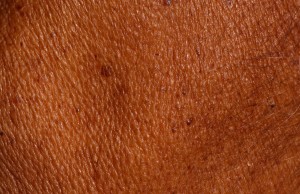He was a god watching over the woman as she slapped at the waves arduously trying to remove her ill fitted orange bathing suit. He glared at the chubby baby whose immature gait tackled the uneven terrain of white sand. This god hovered over the fifty something woman who slept peacefully–after reading five chapters of “Finding Courage”–fully covered in lightweight capris, a longed sleeved shirt and the shade from a blue beach umbrella. Her daughters, he presumed, were not as pious, they baked and allowed god to shimmer against young skin. Three women, the color of Nicole Kidman, strolled delicately in bikinis, while two black women used a camera stick to collect self choreographed memories with the waves that gathered around their thighs. The cacophony of sounds—the chirping birds, the squealing children, music and the otherworldly composition of wind and waves pounding away at the land—made the day perfect. Yet this scene is the typical origin of the most common cancer in America and god, the sun, was giving, and taking away.
More than two million Americans will be diagnosed with skin cancer each year. Eight of ten diagnoses will be that of basal cell skin cancer, with a small percentage of members being diagnosed with squamous cell skin cancer. These cancers are most frequently located on: the head and neck (55%), the back of the hands and arms (18%), legs (13%). Although basal and squamous cell cancers are treatable, deaths from melanoma–the most serious kind of skin cancer—have doubled over the last 30 years, killing over 9000 people annually.
Ultraviolet (UV) rays from the sun (and tanning beds) are the primary cause of skin cancer. Separately, UVB rays are the primary culprit for sunburns, while UVA rays contribute to aging skin. Melanoma—the least common, but most deadly– is caused by intense, occasional sunburns, especially in those who are sensitive.
Those most at risk are people with fair skin, although people with all skin types are at risk and should exercise caution, especially during the long summer months. Men are twice as likely to be diagnosed; it is thought that this is, in part, due their overall greater exposure to the sun, e.g. people who work outdoors. And certainly, if one has been diagnosed with skin cancer before, the risk of a second or third diagnosis is greater than for one who has never been afflicted. Note also, people with a weakened immune system (HIV, transplant patients) and those with chronic inflammatory skin conditions, need to take extra care.
Skin cancer is mostly preventable with simple interventions.
- Wear clothing that guard against the sun’s rays, including sun glasses, as ultraviolet rays also hurt the eyes and predispose the cavalier to cataracts.
- Use of a broad-spectrum sunscreen, SPF 30 or higher, should be applied every two hours and after swimming or profuse perspiration. Sunscreens are not water proof, cannot hold up to a game of volleyball or a jog on the beach and will rub off with wiping or toweling. Ergo, reapply per the instructions on the label: either every 40 minutes or 80 minutes, depending on the formula.
- Strip naked in front of a mirror and spend some time getting to know your skin. Moles that have changed in shape or color is reason seek medical attention.
We have waited patiently for long summer days and the doffing of all things winter, including heavy clothes. The warmth of the sun lifts our spirits, melts away tension and makes us feel good. Enjoy it! But worship with respect, every day and at every venue, whether it’s at the beach or on the way to the work. The sun is the source of life but also has the power to ravage the very organ that literally keeps us in one piece, our skin.
There you have it. Now spread the word!


